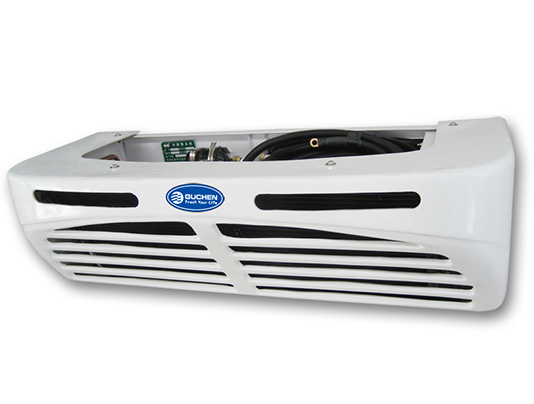
Models:
A truck refrigeration unit, also known as a transport refrigeration unit (TRU) or refrigeration unit, is a cooling or refrigeration unit mounted on a truck or trailer, usually powered by a separate diesel engine or electric motor that drives a compressor to circulate the refrigerant and generate cooling.
The main function of the truck refrigeration unit is to provide a low-temperature refrigeration environment for perishable goods or items that need to be stored in a low-temperature environment during transportation. It is commonly used in the transport of food, pharmaceuticals and other temperature-sensitive products to maintain their freshness and quality.
Guchen Thermo’s Recommendation Based on Models
 |
 |
 |
|
| Model | TR-350 | TR-450 | TR-550 |
| Application | for 15~25m³ truck body | 16~25m³ | 25~35m³ |
| Driven Type | Vehicle engine direct drive | ||
| Refrigerant | R404a refrigerant | ||
| Temperature range |
-25℃ to +30℃ for storage/ distribution of chilled, frozen, deep-frozen food. |
||
| No. of condenser fan | 1 | 2 | 2 |
| No. of evaporator fan | 1 | 2 | 3 |
| Mounting type | Split front mount (nose-mounted) | split front or under mounted | |


| Model | Application | Cooling capacity |
| TS-600 | for 25-35m³ truck box | 5600W/19100Btu |
| TS-800 | 30-45m³ | 7150W/24400Btu |
| TS-1000 | 45~55m³ | 8250W/28150Btu |
| TS-1200 | 55-65m³ |

Introduction:
Features:
A truck refrigeration unit works by utilizing the principles of refrigeration to remove heat from the cargo area and maintain the desired temperature.
Compression: The process starts with the compressor, which is powered by a separate engine or motor. The compressor takes in low-pressure refrigerant gas and compresses it, increasing its temperature and pressure.
Condensation: The high-pressure and high-temperature refrigerant gas then flows into the condenser, which is usually located on the exterior of the truck or trailer. In the condenser, the refrigerant releases heat to the surrounding environment, usually through air or water cooling. As a result, the refrigerant undergoes a phase change and condenses into a high-pressure liquid.
Expansion: From the condenser, the high-pressure liquid refrigerant passes through an expansion valve or orifice tube. These devices act as throttling devices, reducing the pressure and temperature of the refrigerant.
Evaporation: The now low-pressure and low-temperature refrigerant enters the evaporator, which is typically situated inside the cargo area. As air from the cargo area passes over the evaporator coils, the refrigerant absorbs heat from the air, causing the refrigerant to evaporate. This evaporation process cools down the air circulating in the cargo area.
Circulation: Fans or blowers circulate the cooled air from the evaporator back into the cargo area, maintaining the desired temperature. The fans also help distribute the cool air evenly throughout the cargo area.
Refrigerant Cycle: The refrigerant, in its gaseous state after absorbing heat in the evaporator, returns to the compressor to restart the cycle. It is then compressed again, initiating another round of heat absorption, condensation, expansion, and evaporation.
Control and Monitoring: The truck refrigeration unit is equipped with a control system that allows the operator to set and monitor the desired temperature inside the cargo area. The control system regulates the operation of the compressor, fans, and other components to maintain the set temperature.
By continuously cycling refrigerant through the compressor, condenser, expansion valve, and evaporator, the truck refrigeration unit effectively removes heat from the cargo area, ensuring the preservation of perishable goods during transportation.
Truck refrigeration units typically use a variety of refrigerants, but the choice of refrigerant depends on several factors including the specific unit model, regulations, environmental considerations, and efficiency requirements.
R-134a: R-134a is a hydrofluorocarbon (HFC) refrigerant that has been widely used in truck refrigeration systems. It has low ozone depletion potential (ODP) but is considered a high global warming potential (GWP) refrigerant. R-134a has good thermodynamic properties and is compatible with many existing systems.
R-404A: R-404A is a hydrofluorocarbon blend commonly used as a replacement for older refrigerants, such as R-22 and R-502. It is a non-ozone-depleting refrigerant but has a high GWP. R-404A is known for its efficiency and is commonly used in truck refrigeration systems for both cooling and freezing applications.
R-407C: R-407C is another hydrofluorocarbon blend used in truck refrigeration units. It is a non-ozone-depleting refrigerant with a moderate GWP. R-407C offers similar performance characteristics to R-22 but is more environmentally friendly.
R-410A: R-410A is a hydrofluorocarbon refrigerant commonly used in air conditioning and heat pump systems. It has become popular due to its high energy efficiency and low impact on the ozone layer. While it is less commonly used in truck refrigeration units, it may be employed in certain specialized systems.
R-452A (Opteon™ XP44): R-452A, sold under the brand name Opteon™ XP44, is a hydrofluoroolefin (HFO) refrigerant designed as a low-GWP alternative to R-404A. It offers similar performance and efficiency but with a significantly lower GWP. R-452A is gaining acceptance as a more environmentally friendly option in truck refrigeration applications.
Guchen pays attention to the concept of environmental protection and sustainable development, and provides users with the choice of two refrigerants, R134A and R404A, and chooses the refrigerant according to your specific needs. It is worth noting that the field of refrigerants is constantly evolving due to environmental concerns and regulations. With the advent of newer refrigerants with lower GWP and improved environmental profile, R404A refrigerant is now becoming more common in truck refrigeration systems.
Features of Guchen Thermo Quality Transport Refrigeration Unit


Guaranteen :

Inquiry
Please feel free to submit your inquiry information to us. We will contact with you as soon as possible.